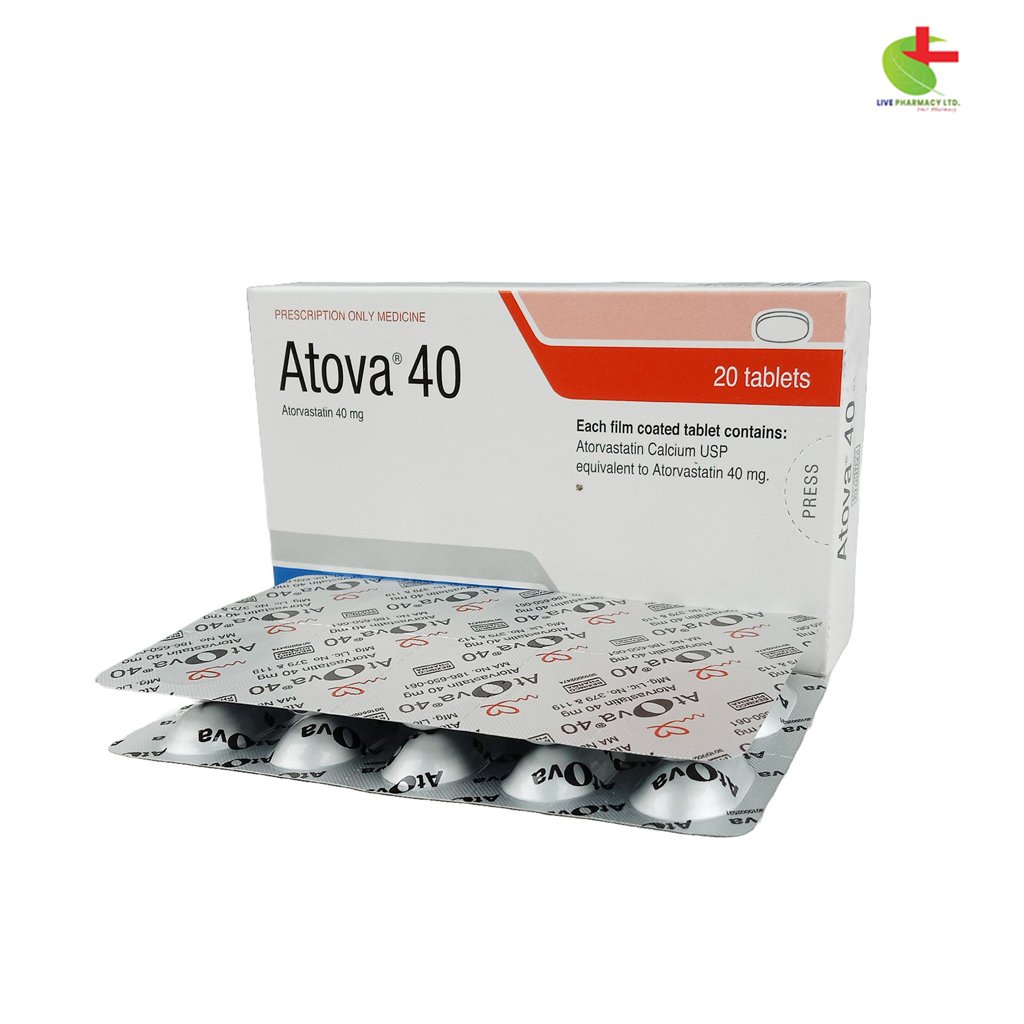Atova 40
280.00৳ Strip
- Atova, by Beximco Pharmaceuticals Ltd., is a potent statin used to lower elevated cholesterol and triglyceride levels when diet alone isn’t enough.
- It helps manage various lipid disorders, including familial hypercholesterolemia and mixed dyslipidemia, and reduces the risk of cardiovascular events.
- Atova works by inhibiting HMG-CoA reductase, a key enzyme in cholesterol production, improving overall heart health.
 Brand
Brand
|
Beximco Pharmaceuticals Ltd |
|---|---|
 Generics
Generics
|
Atorvastatin Calcium |
 Type
Type
|
Tablet |
Indications
Atova is used as an adjunct to diet to manage elevated cholesterol levels, including total cholesterol, LDL cholesterol, Apo-B, and triglycerides, when dietary changes and other non-drug methods are insufficient. It is indicated for:
- Reducing total and LDL cholesterol in patients with familial hypercholesterolemia (both heterozygous and homozygous forms).
- Lowering cholesterol and triglycerides in patients with mixed dyslipidemia (Fredrickson Type Ia and Ib).
- Treating elevated triglyceride levels in hypertriglyceridemia (Fredrickson Type IV).
- Managing dysbetalipoproteinemia (Fredrickson Type III).
- Reducing cardiac ischemic events in patients with coronary artery disease and elevated LDL cholesterol.
- Managing hypercholesterolemia associated with diabetes or renal transplantation.
Pharmacology
Atorvastatin, a selective HMG-CoA reductase inhibitor, decreases plasma cholesterol and lipoprotein levels by blocking HMG-CoA reductase, an enzyme crucial for cholesterol synthesis. This leads to increased hepatic LDL receptors and enhanced LDL uptake. After oral administration, Atorvastatin reaches peak plasma concentrations within 1-2 hours, with a bioavailability of about 14%. The drug is 98% protein-bound and is metabolized predominantly by cytochrome P450 3A4, with active metabolites contributing significantly to its effect. Atorvastatin is excreted mainly via bile.
Dosage & Administration
For primary hypercholesterolemia and combined hyperlipidemia, the typical dose for adults is 10 mg once daily, adjustable to a maximum of 80 mg. For familial hypercholesterolemia, initial dosing starts at 10 mg daily, with possible adjustments up to 80 mg. For cardiovascular event prevention, the starting dose is 10 mg daily, adjusted based on response. Pediatric dosing for children aged 10-17 begins at 10 mg daily, with a maximum of 20 mg.
Interaction
Atorvastatin’s effectiveness may be influenced by interactions with drugs like cyclosporine, fibric acid derivatives, and erythromycin. Co-administration with antacids or colestipol may reduce atorvastatin levels but not its LDL-C reduction efficacy. Concomitant use with digoxin and oral contraceptives may affect drug concentrations, while warfarin interaction is minimal.
Contraindications
Atorvastatin should not be used in patients with hypersensitivity to its components, active liver disease, or persistent serum transaminase elevations. It is also contraindicated in individuals with a history of severe reactions to other HMG-CoA reductase inhibitors.
Side Effects
Common side effects include constipation, flatulence, dyspepsia, and abdominal pain. Less common effects are infections, headaches, back pain, rash, asthenia, and muscle pain.
Pregnancy & Lactation
Atorvastatin is contraindicated during pregnancy due to potential risks to the fetus. It should also be avoided during breastfeeding as its excretion in milk is unknown.
Precautions & Warnings
Liver function tests should be performed before starting treatment and periodically thereafter. Caution is advised for those with liver disease or heavy alcohol use. Discontinue if severe muscle symptoms or elevated CPK levels occur.
Use in Special Populations
Elderly patients may experience higher plasma concentrations of Atorvastatin but show a greater LDL-lowering effect. There is no need for dose adjustment in renal insufficiency, and hepatic impairment requires careful monitoring. Pediatric pharmacokinetics are not well-documented.
Overdose Effects
There is no specific antidote for atorvastatin overdose. Treatment should be symptomatic with supportive measures. Due to high plasma protein binding, hemodialysis is not effective in enhancing clearance.
Therapeutic Class
Statins, Other Anti-anginal & Anti-ischaemic drugs
Storage Conditions
Store in a dry place, away from light and heat, and out of reach of children.













Reviews
There are no reviews yet.